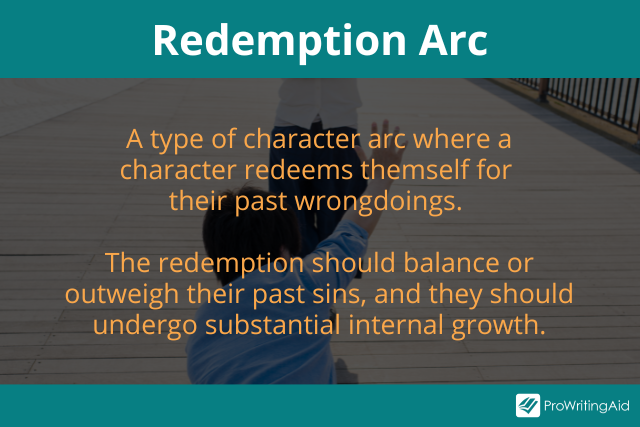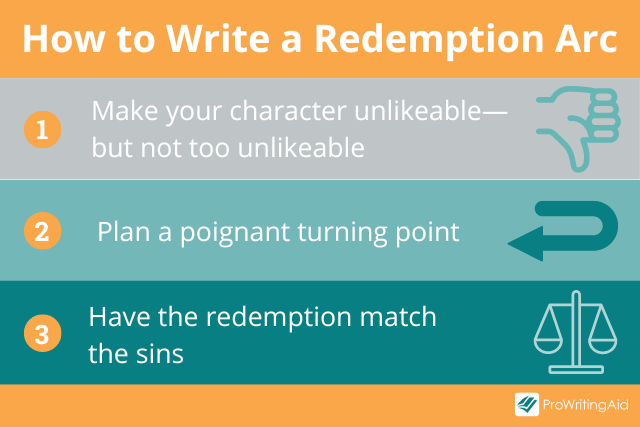
Redemption is a major theme in storytelling because it appeals to our deepest selves. Who doesn’t love a story about someone going through trials and becoming a better person?
A redemption arc is a literary term for a type of character development in which a bad or morally gray character turns into a good person by the end of the story. They redeem their worst sins through their actions in the story’s resolution.
There are some great examples of redemption arcs in literature and media that writers can draw inspiration from. In today’s article, we’re discussing what it takes to craft a great redemption arc.
What Is a Redemption Arc?
A redemption arc is a story arc in which a character finds redemption for their sins, wicked actions, or overall undesirable personality. It requires a few specific features to be truly redemptive.
First, the final redemption must balance out or outweigh the character’s previous actions. You’ve heard of the idea that punishment must fit the crime; in this case, atonement must fit the crime.
For example, let’s say the character with the redemption arc was an abusive parent. Just telling their child they love them once doesn’t make up for all their abuse. A better option would be a major sacrifice because they’ve recognized their wrongdoing. Or perhaps they lose their child but get a chance to raise their grandchild with love.
Second, redemption arcs must accompany substantial character development. One random act of restitution at the end of a story without any internal conflict or meaningful change is not a strong redemption arc.

In a good redemption arc, characters will undergo multiple trials or encounter others who inspire a moral shift. The best redemption arcs will not blindside the reader but instead leave breadcrumbs through the story, so the reader is cheering the character on.
A redemption arc is not just for villains. Both protagonists and antagonists can have redemption arcs, and so can side characters.
Not all redemption arcs come with happy endings, either. Sometimes, a redemption arc comes with a tragic end for that character or the story as a whole.
Regardless of a happily ever after, a redemption arc should be satisfying for the reader. Be careful with a character finding atonement “too late,” as this often feels unsatisfying and pointless to readers.
The Importance of Redemption Arcs
Humans have told stories with redemption arcs for millennia, and they still resonate today. Why? What makes a story about finding redemption so appealing?
The fact is, humans are inherently flawed. We all do things that are wrong, although to varying degrees. But as social beings, we all crave forgiveness, and we all want to know that people are capable of change.
A redemption arc story shows that people can make amends for past mistakes. This is important on a personal level when we feel guilt or shame. Stories give us hope for our own redemption arc.
They also give us hope for a better world when we face everyday evil in the news. The concept of restorative justice in books and media inspires readers not to give up on the world.
Don’t worry about redemption arcs going out of style. As long as people consume stories, they will want to see atonement and forgiveness.
3 Tips for Writing a Redemption Arc Your Readers Will Love
Writing a redemption arc can feel daunting. You want a satisfying, memorable character arc without being cheesy or clichéd.
The good news is that redemption arcs are just a type of character arc. And most stories have character arcs that are intrinsically linked to the conflict.
This means you likely already know how to make your character develop in the story. You just need to keep a few extra things in mind to make your character development redemptive.
Follow these three tips for writing a good redemption arc.
1. Make Your Character Unlikeable... But Not Too Unlikeable!
Finding a good balance of likeability is a crucial component of a strong redemption arc. Your character needs to be flawed enough to warrant true redemption. They must have committed some past mistake that isn’t easily forgivable.
On the other hand, if your character is truly heinous, readers may not want them to find atonement. Nobody roots for Sauron in The Lord of the Rings to have a Grinch-like change of heart.
You can give characters a tragic backstory that explains, but doesn’t excuse, their sins. You can also give them some likeable traits, like intelligence or humor.
Negative character traits that cause wrongdoing don’t have to be cruel or evil. Traits like negligence or hubris often make readers invest in a character’s redemption arc.
For example, perhaps someone your character cared for died because your character wasn’t home. Or maybe they thought they were invincible, only for something tragic to happen.
2. Plan a Poignant Turning Point
Turning points in storytelling denote a narrative shift.
Think of a turning point in physics. Newton’s First Law of Motion teaches that an object at rest or in motion stays that way until acted on by another force. In storytelling, your characters will continue on their same path until you force them into change with a turning point.
With a redemption arc, the turning point must be poignant enough to trigger an internal shift in your character. This doesn’t mean they have to magically become a good person at this moment.
Rather, the turning point should set them onto a redemption quest. This may involve making amends with other characters, or it may involve making sacrifices for the greater good. When a villain has a redemption arc, the turning point is often the reveal of a greater evil.
The turning point should shift the character’s motivations and goals, setting them on a new path through the story.
Turning points affect the pacing of your story. Too soon, and your story will sound rushed. Too late, and your story drags. Use ProWritingAid’s Pacing Report to improve the pacing of your writing.
3. Match the Redemption to the Sins
We’ve already discussed how the redemption should balance or outweigh the past sins or mistakes. It is an important aspect to keep in mind when plotting or editing your redemption arcs.
Someone who caused the death of hundreds of people needs more atonement than buying a homeless person coffee.
Visualize the wrongdoings and redemption as a scale. If the scale leans heavily on the wrongdoing side, you must balance it out. There are a couple of ways to do this without a grand redemptive event.
First, you can make bad things happen to your character to trigger their character development. If their past misdeeds benefitted them, let them experience personal consequences.
Second, you can hint at greater acts of redemption that will occur after the story ends. Maybe the person who caused hundreds of deaths buys a homeless person a coffee on their way to fund the victims’ families or turn themselves into authorities.
To do this successfully, pay special attention to showing an internal crisis and fundamental change. Strong dialogue and inner monologues are essential.

Best Redemption Arc Examples from Literature, TV, and Movies
Let’s look at some great examples of redemption arc stories, from a variety of sources such as classic literature and children’s movies. Be aware that this section contains some spoilers for these books, movies, and TV shows.
Gilgamesh in The Epic of Gilgamesh
The Mesopotamian epic poem is the oldest surviving example of literature, and it’s also a tale of redemption. Gilgamesh is a cruel and tyrannical leader of his people. He commits atrocities regularly, so his people appeal to the gods.
The gods send Enkidu to stop Gilgamesh. Gilgamesh beats Enkidu in battle, but then they become best friends and embark on a journey together. On their quest, they anger the gods.
The gods then kill Enkidu, which leaves Gilgamesh consumed with grief and a fear of death. He subsequently goes on a redemption quest to search for immortality.
Gilgamesh fails, but in the process, he gains understanding and morality. He goes on to spend his life serving others as restitution.
Ebenezer Scrooge in A Christmas Carol
Charles Dickens’ holiday story is one of the most heart-warming tales of atonement. Ebenezer Scrooge, a moneylender, has a reputation for being cold-hearted and miserly. He hoards his wealth but has no love or friends in his life. He’s a ruthless creditor and horrible employer.
Scrooge’s former business partner, Marley, visits him from beyond the grave. Marley warns Scrooge that, if he doesn’t change, he is doomed to spend eternity in the chains of his sins. Marley then reveals that three more spirits will visit Scrooge during the night.
The Ghosts of Christmas Past, Present, and Future take Scrooge on a journey through his own life.
He sees the effects of his past actions. He also learns that his loyal employee has a sickly child, and they cannot afford treatment. Scrooge sees that he will die alone, and people will celebrate his demise.
Scrooge’s internal growth is powerful. He lives the rest of his life as a charitable, pleasant man. He’s a fair employer and becomes like a second father to the sickly Tiny Tim.
The Evil Queen in Once Upon a Time
The hit TV series Once Upon a Time has a great redemption arc for Regina, the Evil Queen from the Snow White story.
Regina cursed all the storybook characters to live a mundane life in modern America. They can’t remember who they are, and Regina rules as a despotic mayor.
Through her love for her adopted son, she begins to change into a better character. Later, she loses the love of her life. She becomes the Good Queen and saves the people she originally cursed.
Theon Greyjoy in Game of Thrones
We see the completion of Theon’s redemption arc in the TV show Game of Thrones. Theon is a spoiled, arrogant boy who betrays his adoptive father and family to establish himself as a leader. He commits several atrocities before he is captured.
In captivity, he is tortured and broken into a meek character by Ramsay Bolton. Theon endures horrible acts of violence and psychological torture. Ramsay keeps Theon as his slave.
Eventually, Theon helps Sansa escape her forced marriage to Ramsay. Then he journeys with his sister to pledge loyalty to Daenerys in her attempt to take the Iron Throne from the despotic hands of the Lannisters.
Finally, he dies defending Bran Stark, the son of his adoptive father Ned, against the Night King.
Boromir from Lord of the Rings: The Fellowship of the Ring
We’re focusing on the movie adaptation of The Fellowship of the Ring for this example, but Boromir is another example from literature, too. Boromir wants nothing more than to make his father proud and defend the people of Gondor.
However, he is arrogant and weak-minded. He believes he can wield the Ring of Power to his will. Slowly, the appeal of the One Ring drives him to attack Frodo.
He realizes his wrongs too late, but he gives his life to protect the hobbits. He takes several arrows, and as he dies, accepts Aragorn as his king.
Gru from Despicable Me
Redemption arcs can occur even in funny kids’ movies, and Gru is a great example.
Gru is an accomplished supervillain, and he has no plans to change. He wants to steal the moon as his ultimate evil act, but first, he must steal a shrink ray from another villain.
Gru encounters three orphan sisters, and he adopts them with plans to use them against his nemesis. But the girls’ love and innocence softens his heart. When his enemy captures the girls, Gru realizes where his true loyalties lie.
He rescues his adopted daughters from the other villain and gives up on his plan to commit his great evil act. In the process, he saves the world. Then he becomes a loving, doting father.
Writing a Great Redemption Arc
Whether you’re writing a romantic comedy, an epic fantasy, or anything in between, redemption arcs can add poignancy to your story.
Readers can relate to a redeemed character. These stories inspire us to be the best versions of ourselves and create a better world through our own redemption.

